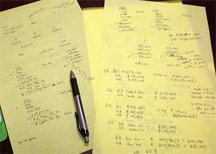Finding doubling time with general numbers
Recall that we started out with an equation:
Nt = N0 2n
Remember the exponential part of this equation is that we raise 2 to the power of the number of generations, n. Another way of saying this is that, for every generation, we multiply the original population by 2.
Let's say I told you that N0 was 10 million and Nt was 80 million one hour later. Luckily for you, these are nice neat numbers. You would probably think to yourself, "well, the population doubled three times, from 10 to 20 million, from 20 to 40 million, and from 40 to 80 million. Since three doublings took 1 hour, each doubling took 20 minutes."
Another somewhat fancier way of getting the same answer would be to substitute the information that you know (Nt and N0) into the equation above, and solve for the information that you don't know (number of generations, n). Here's how that would look with some conveniently chosen special numbers:
Turn on javascript to make this table interactive.
 What is the doubling time?
What is the doubling time?
(10 million -> 80 million in 1 hour)
| Hint | Explanation | |
| Substitute in the known info | 80 million = 10 million * 2n | |
| Divide both sides of the equation by the initial population (10 million) | 8 = 2n | |
| Use trial and error | n must be 3 | |
| 3 doublings in 60 minutes means... | 60min/3doublings = 20min/doubling, so the doubling time (g) is 20 min |
 Let's try the same basic procedure with more general numbers. Let's say the population increased from 10 to 70 million in one hour.
Let's try the same basic procedure with more general numbers. Let's say the population increased from 10 to 70 million in one hour.
Turn on javascript to make this table interactive.
What is the doubling time?
(10 million -> 70 million in 1 hour)
| Hint | Explanation | |
| Substitute in the known info | 70 million = 10 million * 2n | |
| Divide both sides of the equation by the initial population (10 million) | 7 = 2n | |
| Use trial and error...? | n must be ... hmmm... a little less than 3... |
We have not solved our problem yet, and what's in the way is that 2 is raised to some power in order to get 7 -- but we don't have a way to calculate what that power is. In other words, the exponent is the trouble. We need a way to get the "exponential" out of "exponential growth" so we can deal with the maths. But how?
Copyright University of Maryland, 2007
You may link to this site for educational purposes.
Please do not copy without permission
requests/questions/feedback email: mathbench@umd.edu